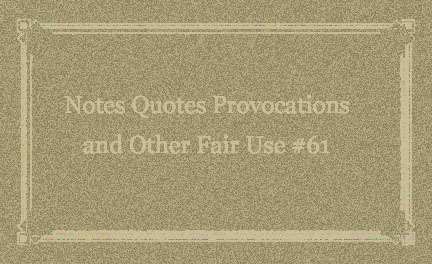

21 November 2002
this all works only if each person makes links as he or she browses, so writing, link creation and browsing must be totally integrated
(Tim Berners-Lee)
wild edit
At an at the latest 6 December to be disclosed URL I have happily started another SWIKI, thanks to the generous help of a Dutch colleague, whose name you'll also find on site. SWIKI being the wonderful tool it is I cannot give away its whereabouts, in order to quietly build some critical mass before releasing it. Its subject matter being Design Recast and its goal printed publication in 2003, its relevance will be clear to speakers and attendees of that symposium, and those who could not attend but have that wild personal publishing talent and are contemporary design savvy.
Parallel to this project last week I submitted the Jan van Eyck's application for some Mondriaanstichting money to set up its own web hosting server, to supply (ex-) (advising) researchers and collaborative partners with the necessary bandwidth, server space and code tolerance to publish their projects. At the same time such service would build context, be self-documenting and -archiving, offering abundant research material.
final will
Final will and testament: who have invested so much in life are obliged and entitled to not a last, but a final will and testament: a true conclusion instead of whatever post mortem. These days Paul is into will and testament mode again. We have gone here before together — with every take-off, I am tempted to say. When recently I was searching also Alamut for the link to Napoleon's will it appeared to be hidden out of sight, or taken down altogether. Once more this is evidence to the web's lack of intelligent editing. Such documents always should be saved in time from unfaithful URLs and their keepers, downloaded to one's private hide-out. Il faut sauvegarder le web!
I want you to get together.
(Paris St. Germain)
|

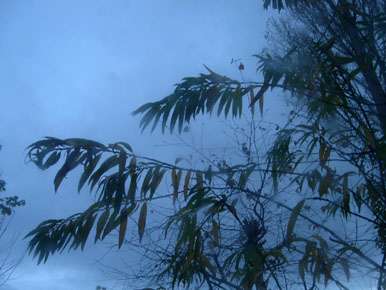

20 November 2002
waiting to see an application open only to have to close it immediately: wrong menu choices drive me to despair every time I release that button too soon
native interactive
A generation born into the age of interactivity is growing up fast. Expect singularity in 2007.
|

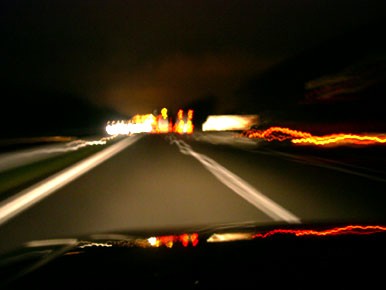
 the way we beam: night view between Lille and Arras
the way we beam: night view between Lille and Arras

19 November 2002
Driving in my car... smoking a cigar...
The only time I'm happy's when I play my guitar!
(Cream's N.S.U., opening 'Fresh Cream', 1964?, with that side 2's classic slowhand Clapton solo in I'm so glad, when 'Stereo' meant that guitar to be in the right channel with the rest of band in the left)
speed of phos
Car and camera that know me shoot me home in 18-19 November's night.
The past week's schedule was demanding but fully worth the detours. With totally opposite speakers ranging from Karen Armstrong to Neil Gershenfield you can calculate my state of mind. I hope to take some of it to the 'Wild Edit' poster in Maastricht on December 6.
|

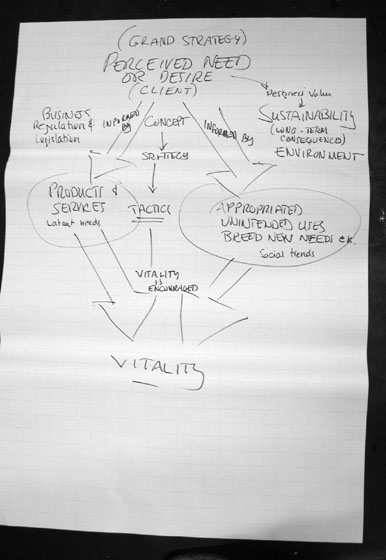
 the way we scheme, Brenda Laurel's handwriting
the way we scheme, Brenda Laurel's handwriting

18 November 2002
...interaction design is the design of the conditions of dialogue, without designing the dialogue itself...
(my 2 cents when asked for a spontaneous definition of i.d. at today's Interaction Design Course Leaders Meeting)
talking affordances
Today some 40 Doors7 attending interaction design course leaders meet at the University of Amsterdam's theatre in the Doelenstraat, next to Café de Jaren. Courses and institutions represented include Ivrea, AIGA, the SMARTlab Centre, Malmö University's Creative Environments, Art Center College of Design's Media Design Program, Musashino Art University, International School of New Media, Design Agenda, Bergen Art Academy's Multimedia department, University of Amsterdam's New Media Department (in dutch), RCA Interaction Design, University of Southern Denmark's Mads Clausen Institute and 'my' Jan van Eyck Academie Design Department.
After introductory rounds discussion groups are formed. I join Brenda Laurel/Nico Macdonald's 'culture/business models' group. For the names of the other participants I have to await the notes. It's a lively group. For cultural clues to design for interaction we come around with above scheme:
(interaction) design takes its initial clues from a perceived need or desire with a party called a client (not exclusively business)
the designer's actions are informed by
> business regulation and legislation
> sustainability or long term consequences for an environment (not exclusively ecology, nature)
> designing products and services, taking into account latent needs, and > appropriating unintended uses, breeding new needs, following social trends, cultural production.
>> the result of which being interaction vitality, moving design up the communication food chain for intervention at the early stage of concept, defining strategy, not tactics to the process.
|

15-17 November 2002
I want my desktop back
(Bill Buxton at Doors of Perception 1, 1993)
If you're not confused, you're not paying attention
(Michael Rothschild at Bionomics Conference 1, 1993)
flow back
First entirely unconnected observations, check out: Loome and Joshua Davis and come back here over the next couple of days for some comment on Doors of Perception 7, 'Flow'.
|

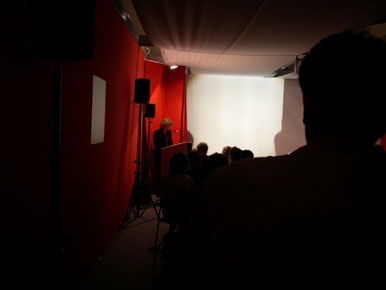 the way we screen
the way we screen

14 November 2002
in camera nostalgia
Photography and the camera. At Paris Photo 2002 the art of capturing light proves its nostalgia for a past when a proper light reflected from proper surfaces of a properly objective world, entering a proper camera obscura to be chemically held and materialize for demonstration, on proper sheets of paper. With the proofs of such proper photos graphein largely on display at the fair comes a proper administrative force: photo graphers, buyers and sellers and an assortment of later day photo entrepreneurs that hire and rent out the locations, fair halls and restaurants and book stands, press booths, information desks. They invite a proper force of legitimizing art historians and critics, to utter the proper lingo of nostalgia illustrating their meagre linear insights on light's progressive travel lensed by generations of artists, meanwhile properly messing with the rattling projection apparatuses that they brought from their museum depots and that do not hide the wrinkles in an improperly suspended bed sheet for a screen.
But where exactly again does today's phos beam, after leniently touching upon scenes before described? Then, how do we capture it and where do we put it, after what kind of processing and to what editorial benefit, to what narrative effect? What is the way we screen? The light remaining the same (one could argue), yet while it is reflecting off like materials and objects many new surfaces are added every day covering the earth — so correctly we are seeing things in a different light altogether, after which most certainly it takes decisively different paths from before.
phos feed
The Nikon Coolpix 4300 comes factory fed with many options. Actually its designers have preconceived its light capturing and storing conditions, and my preferences in such processing. Like the boots that walk me from sub-pavement beaches to carpeted design conferences and photo fairs, the camera shoots me from scanning beach and snow scenes, to copying business cards in badly lit hotel rooms and capturing night portraits taken around some Paris café table. Already — and we're only seeing the beginning of this — the camera, and, to a lesser degree but still, the Clarks, know me. I've been fed into them, with a couple of million other users. Not into their design alone, but deep into their proper functioning, to anticipate and guide my proper functioning as an artist. Of course, this is exactly where the information age will take us, into the heart of our goods and services. Knowing all of us is the information era's original chutzpah.
Stuff, tools and services will get to know us, if not when leaving the factory, certainly after having met us. Its designers and afterwards we ourselves will teach it singlehandedly to help us develop our identities, produce and publish our work, remember and be remembered.
all things tele graphein
With the arrival of objects and tools that identify to render personalized service and express who we are and what our skills are in truly enhancing ways, our proper information graphein will tele-graffiti between us. The original graphein at the time of the 19C industrial revolution made its mind blowing impressions at the Expositions of their time and age. We travelled after those displays to Paris, London, New York, when the world's fairs taught us the latest of the world's fancies. Since roughly a decade the graphein goes tele and we travel at its speed. Coupling the identifying apparatuses and their throughput way tele, distributing whatever graphein (phonos, phos, typos) will properly move mountains. Image distinguished as our media lives are, all that's sent will make all that sense.
|

13 November 2002
Éternelles, inoubliables, une vraie gueule d'atmosphère. Les Clarks sont nées de l'imagination de Nathan Clark en 1949. Mais, télescopage de l'Histoire, les soldats de l'armée de Montgomery, le maréchal au célèbre duffle coat, les portaient déjà durant la bataille d'El Alamein, le 24 Octobre 1942, contre les troupes de Rommel... les Clarks? La Madeleine de Proust des lycéens, etudiants, babas et... des autres de la fiin des annees 60 et du début des seventies.
Aujourd'hui les jeunes Italiens les venerent encore mais en blue marine. Paradoxalement les Clarks symbolisent une France forte: celle de "l'avant choc pétrolier" de 1973... Un pavé à la main et chaussée de Clarks, toute une jeunesse rejoint les cortèges ouvriers pour scander "Pompidou des sous".
(from: 'The Clarks Desert Boot — 50 years of style; the amazing return of the brothel sneaker')
shopping for ops
I seem to share a history with the boots that walk me — 'pavé à la main' style. The idea of empowerment from commodities is a sustainable one. As much as these bleu marine boots, also the camera and many other goods or tools extend not only my skills and mobility, but enhance the very understanding of life and ones power to change some of its habits (was: 'rules', was: rules in the 1960s-70s, still is: rules for the rulez-types). Every object enlarges my possibility space, offering the promise to act upon or through it. The symbolic power of objects goes far beyond their simple economical status. Goods connect us to their worlds of materialization, where nothing is, unless it has colour, smell, touch, bringing direct sensations to the body, which is so needy for ekstasis, as also Karen Armstrong argued yesterday evening.
|

12 November 2002
Let all beings be happy! Weak or strong, of high, middle, or low estate.
Small or great, visible or invisible, near or far away,
Alive or still to be born — may they all be entirely happy!
Let nobody lie to anybody or despise any single being anywhere.
May nobody wish harm to any single creature, out of anger or hatred!
Let us cherish all creatures, as a mother her only child!
May our loving thoughts fill the whole world, above, below, across — without limits, a boundless goodwill toward the whole world.
Unrestricted, free of hatred and enmity!
(Karen Armstrong, quoting a prayer from the Sutta-Nipâta, ending her lecture 'Faith after September 11th')
When Paul writes 'anniversary' for November 11 2002, and I can't seem to remember this date is his birthday which is more Septemberish... (but here I can be off) I flash back to previous Alamut November 11s and hit on 2000, for other buddhas. That was at the time of a previous Doors. The upcoming one will bring Stewart and Caterina back to A. Guess though Paul's celebrating this November 11.
ops
After so many years I upgrade from Ma old faithful 'disk error c:13:01' Vica. R+r will have it at home. For the high mobility image intensive attendances ahead I acquire a 4Mp camera. I am no photographer. But as NQP proves I witness occasional events that communicate well in an image format. And of course I'm concerned with the question of light.
|
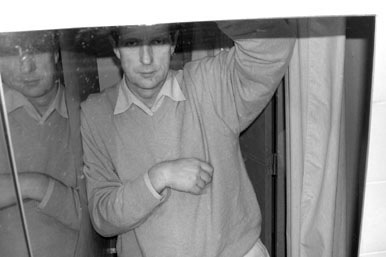 the way we screen
the way we screen

11 November 2002
home away from habit
No such thing exists. What I miss most when out there is that Moulin household, the odd jobs, routines that clear the head, everyday ordering and storing, piling stuff on the desk or above the sink, some cleaning and sweeping, garden rounds if the weather invites it.
|

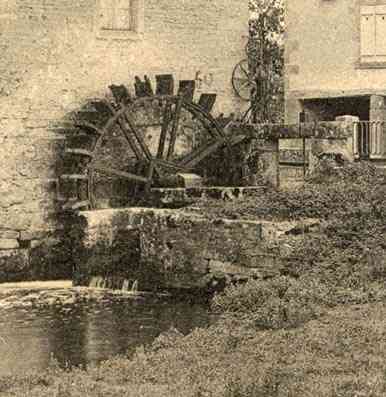

8 November 2002
Is het niet al bijna gewaagd verfijnd om bij tijden alleen door het medium van een derde met elkaar in contact te komen?
(Robert Musil in a letter to Gustl 13 June 1905, in Cahier II)
A. is a simple man
The list I start today is called A. is a simple man. It is a narrow interest one-list-fits-all kind of list, you know. 'A. is a simple man who takes long showers to get simple ideas.' Like that. Probably a list of/on habits, observations? Are lists 'on' what's listed? Let's find out.
|

7 November 2002
Ich sage: jeder Mensch hat ein ganz besonderes Bewusstsein, eine Möglichtkeit. Diese Möglichkeit ist nicht abgeschlossen. Diese Möglichkeit kann man also zu einer grösseren Möglichkeit entwickeln. Und das kann man am besten durch — ja, sagen wir einmal, durch eine Schulungs- und Informationsvorgang. Aber dieser Schulungsvorgang sollte wiederum nicht autoritär sein, sondern er sollte oszillierend zwischen Menschen stattfinden, das heisst, ein universelles Lehrer- und Schülerverhältnis sein. Zwischenmenschlich. Im Grunde so universell, dass man sagen kann: Die Sprache selbst ist der Lehrer. Das heisst, in dem Augenblick, wo ich spreche, bin ich mal im Moment der Lehrer. Und wo ich zuhöre bin ich der Student — nicht? Also wenn ich Ihnen zuhöre, bin ich der Lernende. So universell müsste man das auffassen. Und das wollen wir regelrecht hervorrufen. Dass also die Sprachlosigkeit zwischen den Menschen überwunden wird, das ihre Isolation und ihre, sagen wir mal, Abtrennung des einen Menschen vom anderen überwunden wird.
(Joseph Beuys 1972, in Jeder Mensch ein Künstler)
extremely fittingly
One site fits all. Every container is constituted with a contained, and vice-versa reformats its content. Taken to publishing, a weblog with its 24/7 update regime fits all it fits all of the time: work and pleasure, private and public memory, opinion and fair use, map and terrain. Its limitations are the limitations of a sleepless mind which can go wrong all of the time and ever so many restless hits which address it. How much throughput can one, does one allow oneself to, perform? What is hidden from the weblog is not given enough energy, not enough attention, to fit in. 'Fitting in' means changing something in order to contain it — formatting it. 'One site formats all' is as true as 'one site fits all'. The container is the state of whatever it fits into its format. QED NQP et OFU.
The Moulin is a different mill in NQP from what it is in lemoulindumerle.com. My pondering here on design and media are different from what is formatted in idie.net. In NQP every entry operates on the level of the weblog, the daily operation which fits to the particular everything-and-the-kitchen-sink style of its publishing. At lemoulindumerle.com things move much slower because I move slower there and no third party attention speeds me up. lemoulindumerle.com moves at estate speed, where in situ only after three years we started reformatting some of the parts, hesitantly. Meanwhile, like we live the Moulin everyday, I live NQP, not so lemoulindumerle.com. Life at the Moulin modifies that place — life at NQP changes its format, in a sense purposeless, change coming like wear with life. To translate life at the Moulin to lemoulindumerle.com is more of an effort than to simply live it in NQP, where whatever I live is lived as long as it fits the format. The more I fit it fits. Live the biography, my friends.
|
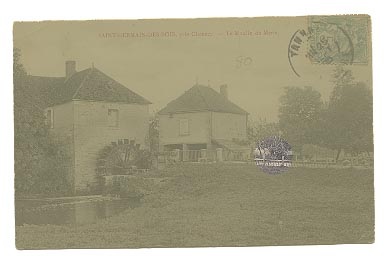 location of worker, just over the bridge on the island
location of worker, just over the bridge on the island
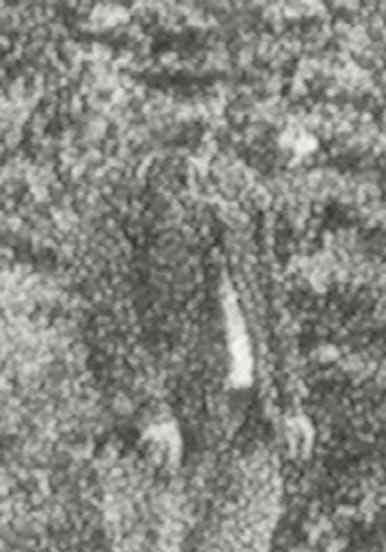 worker at the Moulin du Merle around 1850s
worker at the Moulin du Merle around 1850s


6 November 2002
het geheim van het leven is dat het niets nieuws is
stationary
The envelope contains three folded double sheets of paper and three envelopes. The slightly yellowed white paper has 10mm wide mat black print lines around the edges front and back, so they double along the fold. The envelopes are equally lined black on the front, and back along the sides of the flaps. The closed envelope shows an X shape.
|
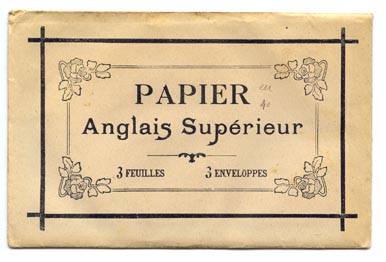 package 180x117mm;
package 180x117mm;

folded double sheet 110x174mm; envelope 120x91mm


5 November 2002
Je hais tous ces individus incapables de s'arrêter longuement devant une feuille, de se perdre à regarder un arbre et que je vois chacun avec son "journal", le nez dedans, l'esprit échauffé par le babil affreux et puant de ce papier, ahuri d'incohérence, des mots obscènes de la "politique", crédule jusqu'à la nausée, absorbé par le nouveau de la nouvelle et incapable du nouveau inépuisable de ce qui est toujours — et sous nos yeux...
(Paul Valéry)
nothing new
When on both Rolf and Roemer's birth announcements in 1993 and 1995 I wrote het geheim van het leven is dat het niets nieuws is, 'the secret of life is that it is nothing new', this of course contrasted the reoccurring 'new' of the market place and media invention with ever present life and death in time. For my mourning card I could use that very same line. But that's another story. Roemer's birth announcement got me a hate mail postcard by an anonymous sender, who years later accidentally proved to be the same person who had asked me for an explanation two-and-a-half years before, when she received Rolf's birth announcement. Sitting beside our firstborn's crib I thought I had sufficiently explained this young shrink, mother of three, my deep truth of the not-so-new to come to visit us, if we were ever so graced as to procreate.
As with usefulness/uselessness, between market place media inventions, le nez dans le journal, and eternal presence, ce qui est toujours, we balance our attention. In my life neither one does dominate the other, a fact which at sentimental moments I can be sorry of. Wild talent as blind talent in the sense of not being distracted ever, I can envy. Then again I get understandably distracted by a passing butterfly in January.
|

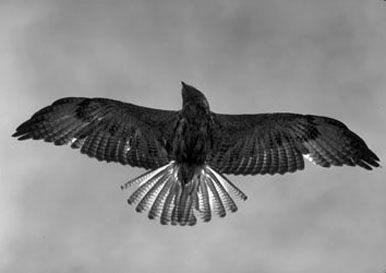
|
galapagos hawk
4 November 2002
La vraie valeur des 'théories' n'est pas la valeur théorique. Mais les effets réels.
(Paul Valéry)
theory revisited re-invested
You can't be serious. This sound advice came from Jan van Eyck cultural theory researcher Robert Garnett when he left the academy in 2001. Last Saturday the theory department organized a roundtable called 'inhabiting theory'. I wished for Robert to be present. After listening to two hours of disciplinary ruminations, I put something on the table that I knew, as above quote reminds us, I would find a serious Paul Valéry on my side, so I asked: why the inescapable academicism? Why still try to figure out inspiration and legitimization exclusively and mutually between the fine arts, design and theory, or, critically-or-not, ponder each discipline's self-inspiration and self-legitimization? While each has disitinct multiple productions of its own, with real effects for any societal discipline which itself does not claim or pretend to be, nor to produce 'art', 'design' or 'theory'... There still is a choice of disciplines that do not put out such commodities, but use theory, art and design's products to inform its proper production of knowledge, education, politics, economics, social organization, business and what have you.
Why not first of all, to the advantage of the dear threesome, acknowledge that especially outside art, design, theory, there's this wide range of very productive, not to say creative, and at any rate very hungry for art, design and theory, societal practices, which should inform what exactly we inhabit in the first place, if we discuss 'inhabiting' theory, or art or design for that matter.
My remark was mistaken for a critique on ivory tower thinking. It wasn't. I have a superficial idea of what informs contemporary theory, outside theory, art or design. My observation was about defining deeply enjoying any idea and production in theory, art or design (possibly conceived and manipulated in tragic isolation, but happily disclosed at some point) in its context of a market, of a product, a publication, some public offer, generosity, media, the everyday. Defining theory, art and design as functions of each other, or legitimizing theorists, artists and designers as producing theory, art and design, even in cross-disciplinary contamination, will not escape self-apologetic disciplinary definitions. Looking for an effect on extra-disciplinary interests does not prevent a theorist from producing stunning art or design, or a designer publishing selling speculation, or any other accident to happen between the three — this has happened all the time and will happen forever — it just means that at the end of professionalism we will find new professions, at the end of consumption new commodities emerge. Disciplines are here to stay. Disciplines are here to change.
any discipline you like as long as it's useless
For certain theory, art and design 'usefulness' just kills it, filling the void. Rather than killing useless space I hope to create it. Empty, empty, empty. Of the three disciplines under investigation art is generally accepted to be of greater uselessness than design or theory. Good for art, but YMMV. When we substitute possibility by necessity we deplete useless space, of which exists in certain periods and milieus and in certain lines of thought a limited supply already. Horror vacui is a common infirmity. I was drawn to art for its uselessness alone. See the Man Ray, see the Mondriaan, zip pow see the Herriman, hear that Beefheart grunt! My taste for useless theory and design I acquired over the years. You can't be serious. But we are. Uselessness is a serious proposition.
note to self
100% Off! The Material World Wants To Be Free.
|

3 November 2002
and back again
I drive 900 kilometres from Zevenaar to pick up G+R+r in the Hague and return us to the Moulin. Yesterday was Zevenaar-Maastricht v.v.: another 360 kms. All the time we drive under great skies. Today's sunset is a blast of pinks, oranges, greens, purples and greys, turning to deep blue ink. The way the clouds are divided in packs and flocks, where the mass and where the open space is, directs the light and colors it gold or silver. We see linings, rays and rainbows. At home we find some of the five remaining cats, Ms. van Citters in a very clean place, all plants entered because already nights were freezing, Mr. van Citters in bed with funny tummy because he spent too much time on top the water wheel in a damp environment. I open a bottle of Coulange-la-Vineuse and eat a chunk of the old Gouda we brought, Opening the 01Book I find a subsidy request I should finish tonight. This is where I live.
|

 about the author
about the author

|
|


